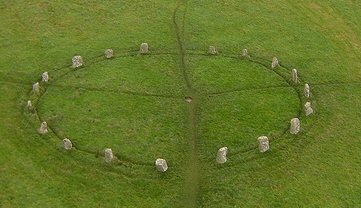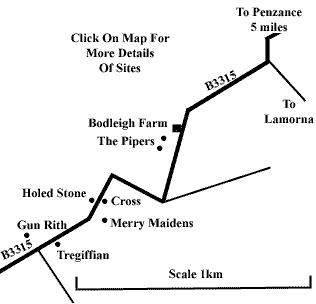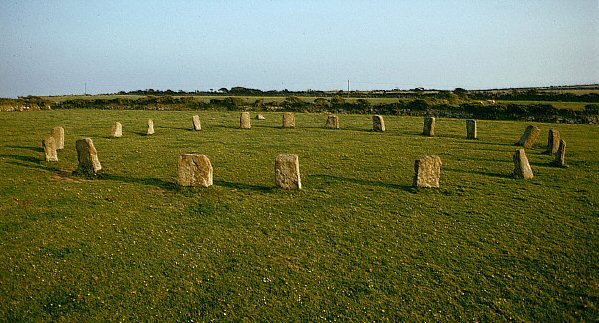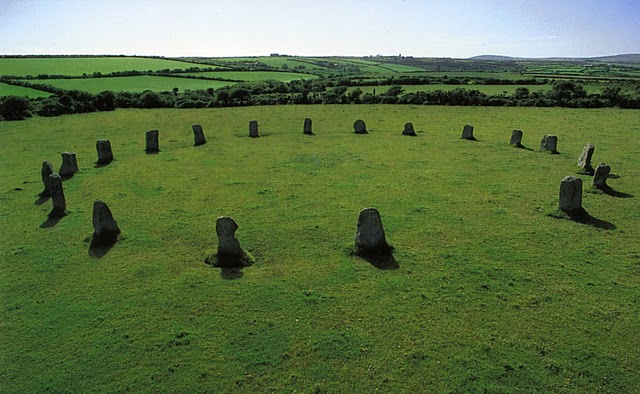|
Location:
Cornwall, Near Trewoofe.
(SW 432 245). |
Grid Reference:
50� 3' 54.5" N,
5� 35' 19.34" W. |

 Merry Maidens:
(Stone Circle).
Merry Maidens:
(Stone Circle).
This is the best known and preserved circle in Cornwall: it is
believed to be complete, which is rare in itself. Its nineteen granite stones are
not large (The tallest, 1.4m high, is in the south west, and the shortest
directly opposite), but neat and regular, and form a perfect circle of
23.8m (77ft 10in) diameter. The stones are regularly spaced and exactly at
the east there is a gap (an entrance or the site of a missing stone).
The Merry maidens were re-erected 1860-70. They are regularly spaced apart
by 3.7m each.
|
The Merry
Maidens:
(S1/14) ('Dawns
Men') |
Rosemodress Circle, Rosmodreuy Circle, Dons
Meyn, Dans Maen, Dawn's Men, Boleigh Circle, Boleit Circle.
The Merry Maidens stand at the centre of a
large complex of prehistoric monuments which include the
Tregiffian Entrance Grave, the Pipers, and other menhirs, holed
stones and barrows. There are also references to a further stone
circle close by.

Other Sites in the Vicinity of the Merry
Maidens.
Restoration works carried out in the middle
of the 19th century replaced some of the stones incorrectly and
altered the originally even spacing between the uprights.
Individual stones would appear to have been carefully chosen for
their shape and size. Their flat inner faces are arranged along
the circumference of the circle, their tops are flat and level,
and they are graded in size, the tallest stones lying in the
south-west quadrant of the circle. Early reports of the site
refer to traces of an earth bank, particularly noticeable around
the south and west sides.
(1)
There is some evidence for the
existence of a second stone circle close by, although its exact
location is unknown. From accounts by Dr Borlase it would have
been of a similar size to the Merry Maidens, although by the
19th Century only seven remaining stones were to be seen, four
of which were still upright. There are no traces of this site
today. (1)
Tradition and
Legend:
Although the Merry Maidens are also called Dawn's Men. This name has nothing to
do with sunrise: it is a corruption of Dans Maen, or Stone Dance
in Cornish: a story of nineteen maidens dancing on a Sunday who were
transformed into stones. The pipers that had played for them were
petrified too: the two standing stones called the Pipers are in a field to the
north-east of the circle. This legend was probably initiated by the early
Christian Church to stop the pagan Cornish peasantry continuing old
habits.
Petrifaction legends (people
are turned to stone), are commonly associated with stone
circles, being reflected in their names, for example, the
Tregeseal Dancing Stones, the Nine Maidens of Boskednan, as well
as the more distant
Hurlers and the Pipers on Bodmin Moor.
One of
two holed stones known in the area, now the gatepost to a
field to the north, was recently known as a �betrothal
stone� through which engaged couples held hands.
(More
about Holed Stones)
Archaeoastronomy.
In West Penwith
there are 5 stone circles with nineteen stones including this one
(Boscawen-un and Tregeseal). This is loosely suggested to relate to
the lunar cycle of 18.6 years or the 19 year Metonic cycle of the
sun and moon.
Sir Norman
Lockyer suggested the the Merry Maidens (and the nearby
Pipers) were one of several sites where Arcturus was used as
a 'star-clock' (2).
Merry Maidens: Photo
Gallery.


Desecration of
the Merry Maidens:
Article:
Cornwall Archaeological Unit's Review of 1995-6.
"The Merry
Maidens (SW433245) is one of the best preserved and probably the
best known stone circle in Cornwall. It came as a shock then, in
June 1995, when Mike Rosendale of Penwith District Council
reported that the circle had been vandalised; one of the stones
had been uprooted and left prostrate on the ground. Before the
stone was re-erected the stone hole was excavated by Charlie
Johns and Andy Jones of the CAU. They made the surprising
discovery that the stone had originally been set at right-angles
to the circle and that when restored in the 19th Century it had
been turned through 90 degrees and placed in line with the
circle. On this occasion the stone was set up again as it had
been before vandalism".
(More
about Desecrated Megaliths)
(Other
Stone Circles)
(Other
Prehistoric English Sites)
|



